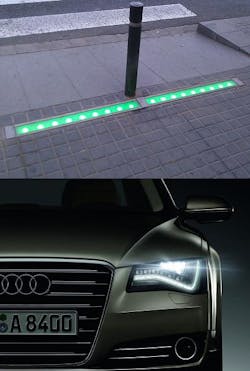Osram LEDs help create new automotive-lighting applications
Sunnyvale, CA--Osram Opto Semiconductors' active development of automotive LED technology is paying off handsomely in the form of moneymaking production devices. The company's technology is being used in the "Light Line," a pedestrian-warning system based on LEDs installed in the pavement that switch from green to red to show pedestrians when the street can be crossed safely. The new warning light was developed by DSTA, a Spanish company that designs and manufactures LED devices for traffic lighting and transportation. The colors in the signal light are provided by Osram LEDs that have an average operating lifetime of up to 100,000 hours. The first test installations of the "Light Line" are in place in the Spanish cities of Burgos and Terrasa, with additional projects to be launched in the near future.
LED headlamp has cornering-light function
Osram also was an award winner at the 17th Annual Automotive News PACE (Premier Automotive Suppliers' Contribution to Excellence) Awards for innovation held yesterday (April 11, 2011) at the Max M. Fisher Music Center (Detroit, MI). Osram's OSTAR headlamp LED won an award in the product category, which honors innovation in new products, components or systems that have significant market impact and act as "game changers" in the automotive industry.
The headlamp LED uses what the company calls "ThinGaN" LEDs with phosphor-layer transfer. The headlamp includes a integrated shutter function to control the output of the light. Used in the top-of-the-line Audi A8 sedan, the Osram OSTAR LEDs allow headlamp lighting functions beyond simple low and high beams, such as daytime running lights, cornering lights, and all-weather lights.
Subscribe now to Laser Focus World magazine; it’s free!

John Wallace | Senior Technical Editor (1998-2022)
John Wallace was with Laser Focus World for nearly 25 years, retiring in late June 2022. He obtained a bachelor's degree in mechanical engineering and physics at Rutgers University and a master's in optical engineering at the University of Rochester. Before becoming an editor, John worked as an engineer at RCA, Exxon, Eastman Kodak, and GCA Corporation.
